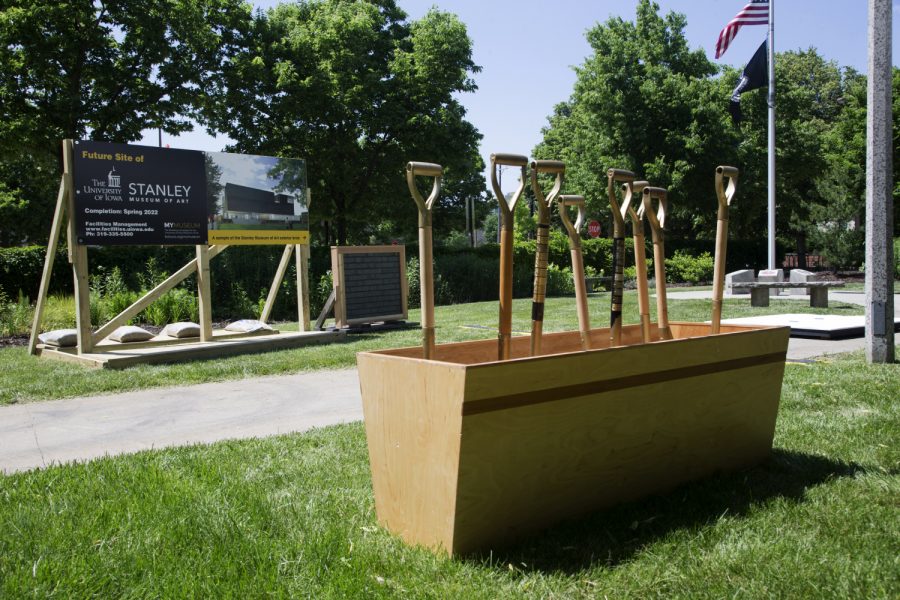New Stanley Art Museum breaks ground, ‘beginning of the end’ in flood recovery
Construction on the new Stanley Museum of Art is officially underway. The new $50 million, 63,000-square-foot museum should be completed in 2022.
The shovels used for the at the Stanley Museum of Art ceremonial groundbreaking ceremony are seen on Friday, June 7, 2019. (Emily Wangen/The Daily Iowan)
June 11, 2019
For 11 years, the Stanley Museum of Art’s 15,000 works of art — including works by Picasso and Jackson Pollock — have been without a permanent home.
Soon, the works will return to the University of Iowa campus, with construction on the new Stanley Museum of Art set to begin in the fall. The UI broke ground on the 63,000-square-foot site on June 8. The $50 million museum, located south of the Main Library in Gibson Square, is slated to be completed in the spring of 2022.
The original museum was located on the west bank of the Iowa River and was heavily damaged in the flood of 2008. While rescue efforts saved all of the museum’s collection, no location on campus was large enough to house all the artwork. There is limited display space in the museum’s current IMU location, so much of the Stanley’s collection resides in the Figge Museum of Art in Davenport or is on loan to other museums around the country.
The Stanley is the last major construction project in the UI’s flood recovery. In his remarks at the groundbreaking, UI President Bruce Harreld called the construction of the new museum the “beginning of the end of the recovery.”
RELATED: UI Museum of Art celebrates 50th anniversary
Half of the $50 million funding comes from donations — both large and small. The other $25 million comes from the UI general fund.
Senior Vice President of Finance Rod Lehnertz said the UI Center for Advancement was tasked with raising $25 million for the construction of the new museum after appeals to the federal government for funding proved to be unsuccessful.
Lehnertz said he hopes the museum’s new central location near the Main Library will increase student engagement with the museum — calling the museum a “gateway feature” for the university.
“With the museum in its former location — less than half of the students graduating from the UI knew we had a museum — much less had visited one,” Lehnertz said. “We’ve changed a lot since then, and that’s why this site is so important to us — to be in the midst.”
2019 marks the 50th anniversary of the museum. Museum Director Lauren Lessing said the idea of what a university museum should be has changed drastically in the 50 years since the facility opened its doors.
“The old Art Museum was a beautiful display space for our collection, but it was not designed with teaching in mind. That was in the mid-20th century, when art museums were mostly intended as spaces of display,” she said. “Now, the function of art museums has really changed — particularly on college campuses.”
RELATED: UI planning groundbreaking for Stanley Museum of Art
The new three-story museum will feature display space, classrooms, outdoor terraces, and a lobby that can serve as a place for performances or a study space for students.
The new Stanley will sit atop a parking garage to replace the current surface lot behind Gibson Square, which will also serve as a flood-control measure.
Steve McGuire, the director of the School of Art and Art History, said the Stanley serves as an important place for students to gain career experience in curatorial work and to learn from the work in the collection.
“It has work that is important for students to see so as to situate the work that they do in becoming an artist,” he said. “Anybody who produces artwork is having a conversation with all the artwork that’s been created.”
While the Stanley is an important space for learning on campus, in her remarks at the groundbreaking, Advancement Center President Lynette Marshall emphasized that the Stanley is an institution for all Iowans, not just UI students.
“Today, it truly is the museum of the people of Iowa,” she said. “Everyone has a stake in this museum. They can all say, ‘This is my museum.’ “



